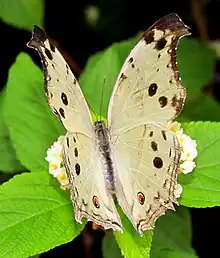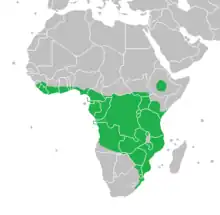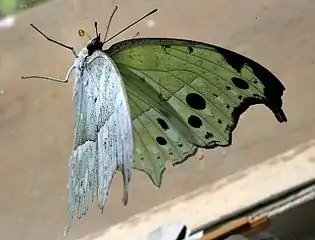Protogoniomorpha parhassus
Protogoniomorpha parhassus, the forest mother-of-pearl[1] or common mother-of-pearl,[2][3] is a species of Nymphalidae butterfly found in forested areas of Africa.
| Forest mother-of-pearl | |
|---|---|
 | |
| possibly P. p. aethiops | |
_underside.jpg.webp) | |
| P. p. parhassus, Ghana | |
| Scientific classification | |
| Domain: | Eukaryota |
| Kingdom: | Animalia |
| Phylum: | Arthropoda |
| Class: | Insecta |
| Order: | Lepidoptera |
| Family: | Nymphalidae |
| Genus: | Protogoniomorpha |
| Species: | P. parhassus |
| Binomial name | |
| Protogoniomorpha parhassus | |
 | |
Approximate range | |
| Synonyms | |
| |
Subspecies
- P. p. parhassus, the forest mother-of-pearl, from Tropical Africa[4]
- P. p. aethiops (Palisot de Beauvais, 1805), the common mother-of-pearl from southern Africa[4]
Description
The following description is for P. p. aethiops: A large butterfly;[3] the wingspan is 65–80 mm for males and 75–90 mm for females.[2] The male and female are similar in colour and pattern.[3] The base colour of the upper surface of the wings is greenish white with a violet sheen in the wet-season form, and pearly white in the dry-season form.[3] The forewing has a black-tipped, hooked apex. The wings have a few red eyespots which are ringed with black. There are black spots near the margins of both the forewings and hindwings. The underside of the wings has a greenish-white base colour, with eyespots corresponding to those on the upper surface.
Life cycle
Larvae
The larvae are similar to those of Junonia and Precis species, but larger.[5] They feed on Asystasia (A. gangetica[3]), Brillantaisia, Isoglossa (I. woodii[3] and I. mossambicensis [6]), Mimulopsis, and Paulowilhelmia species.[1][2]
Pupae
The pupae are similar to those of Junonia and Precis species, but larger.[5]
Adults
The flight period of the adults is year round, peaking in summer and autumn.[2] They have a "ponderous, flapping flight which can be quite fast".[3] The males may perch on the leaves of forest trees, while the females stay closer to the ground near the larval food plants.[3] These butterflies roost under leaves at night, and the males sometimes mud-puddle.[3]
Gallery
 P. p. aethiops in Eswatini
P. p. aethiops in Eswatini P. p. aethiops in South Africa
P. p. aethiops in South Africa_(7710539524).jpg.webp) P. p. parhassus, Cameroon
P. p. parhassus, Cameroon
References
- "Salamis Boisduval, 1833" at Markku Savela's Lepidoptera and Some Other Life Forms
- Woodhall, Steve (2005). Field Guide to Butterflies of South Africa. Cape Town, South Africa: Struik. ISBN 978-1-86872-724-7.
- Williams, M. (1994). Butterflies of Southern Africa; A Field Guide. ISBN 1-86812-516-5.
- Markku Sevala's pages: http://www.funet.fi/pub/sci/bio/life/insecta/lepidoptera/ditrysia/papilionoidea/nymphalidae/nymphalinae/salamis/index.html, retrieved 31 July 2010.
- Woodhall, S. (2008). What's that Butterfly?. Cape Town: Struik Publishers. ISBN 978-1-77007-486-6.
- Dickson, C.G.C (ed.), Kroon, D.M.; Pennington's Butterflies of Southern Africa; AD. DONKER 1978
